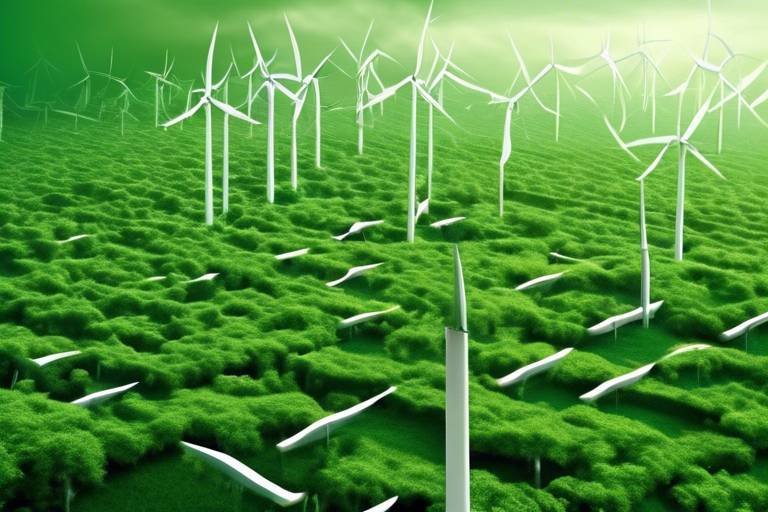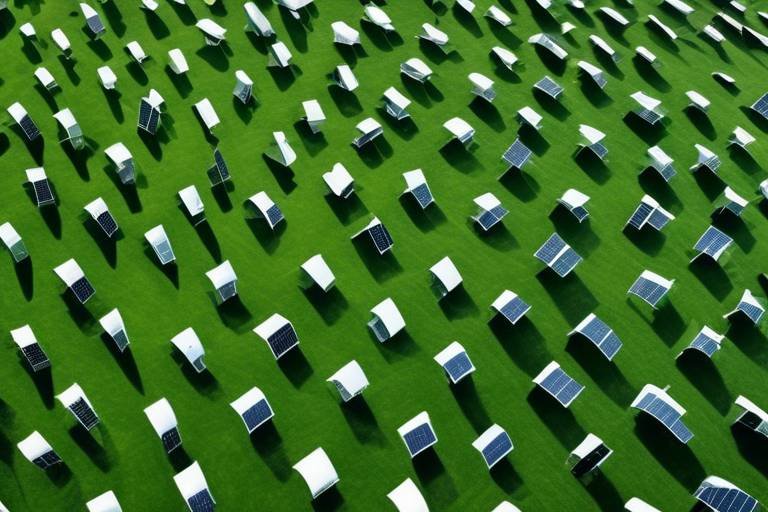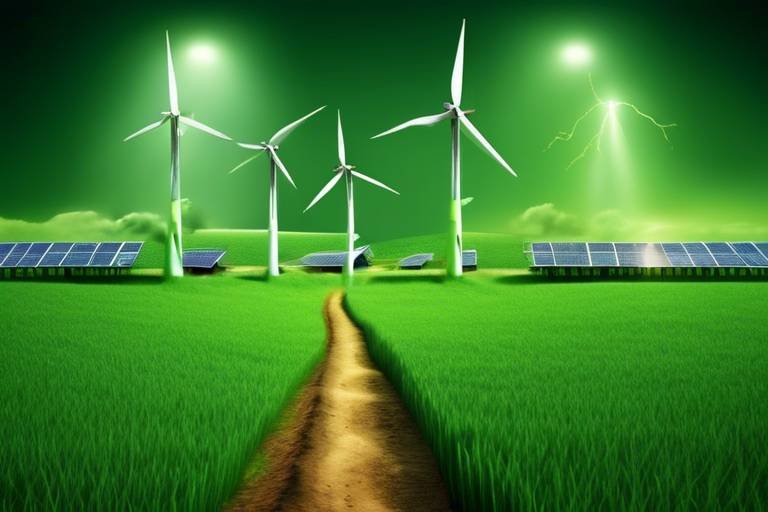Green Energy Solutions - Busting the Myth of Unpredictability
In recent years, the conversation around energy has shifted dramatically, with a growing emphasis on green energy solutions. As we face the looming threat of climate change, many are turning to renewable energy sources as a viable alternative to traditional fossil fuels. However, a persistent myth lingers in the air: the notion that green energy is inherently unpredictable and unreliable. This article dives deep into this misconception, shedding light on the advancements in technology and the inherent reliability of renewable resources. By the end, you'll see just how dependable green energy can be, paving the way for a sustainable future.
First, let’s clarify what we mean by green energy. This encompasses energy derived from natural sources that replenish themselves, such as solar, wind, hydro, and geothermal energy. Unlike fossil fuels, which can be depleted and are harmful to our environment, green energy sources offer a clean and sustainable way to power our lives. They play a crucial role in reducing greenhouse gas emissions and combating climate change, making them essential in our quest for a healthier planet.
Many skeptics argue that green energy sources, particularly solar and wind, are too variable and unreliable to meet our energy needs. But is this really the case? Let's take a closer look at the facts. Numerous studies and real-world examples demonstrate that advancements in technology have significantly enhanced the reliability of these energy sources. For instance, modern solar panels are designed to capture sunlight efficiently, even on cloudy days, while sophisticated wind turbines can generate power even at low wind speeds.
Consider this: the unpredictability of green energy is often overstated. With the right technology and infrastructure in place, we can harness these resources consistently. For instance, solar farms can be strategically placed in areas with high sun exposure, and wind farms can be located in regions where wind patterns are stable. Furthermore, advancements in energy storage solutions, like batteries, allow us to store excess energy generated during peak production times, ensuring that we have a reliable supply even when the sun isn't shining or the wind isn't blowing.
As we explore the innovations in solar and wind energy, it becomes evident that these technologies are not only evolving but are also becoming more accessible and affordable. The cost of solar panels has plummeted in recent years, making them a practical choice for homeowners and businesses alike. Similarly, wind energy has seen a surge in investment, leading to the development of more efficient turbines that can generate power more consistently.
In conclusion, the myth of unpredictability surrounding green energy solutions is slowly being dismantled by technological advancements and a deeper understanding of renewable resources. As we continue to innovate and adapt, it’s crucial to embrace these changes and recognize the potential of green energy as a reliable source of power for our future.
- Is green energy really reliable? Yes, with advancements in technology and energy storage solutions, green energy sources like solar and wind have become increasingly reliable.
- What are the main types of green energy? The main types include solar, wind, hydro, geothermal, and biomass energy.
- How does energy storage improve green energy reliability? Energy storage systems, like batteries, allow for the capture and storage of excess energy, ensuring a consistent supply even when production fluctuates.
- Can green energy meet our energy demands? Yes, with proper infrastructure and technology, green energy can meet and even exceed our energy demands sustainably.

Understanding Green Energy
This article explores the reliability of green energy solutions, addressing common misconceptions about their unpredictability and highlighting their potential benefits for a sustainable future.
Green energy refers to renewable energy sources that are not only sustainable but also environmentally friendly. In our rapidly changing world, where climate change is a pressing concern, understanding green energy is more important than ever. It encompasses a variety of energy sources that harness natural processes to generate electricity, heat, and fuel. The most common forms of green energy include:
- Solar Energy: Captured through solar panels, this energy source converts sunlight into electricity, making it one of the most accessible forms of renewable energy.
- Wind Energy: Generated by wind turbines, wind energy harnesses the power of the wind to produce electricity, often on a large scale.
- Hydropower: Utilizing flowing water, hydropower is one of the oldest forms of renewable energy and is particularly effective in areas with significant water flow.
- Geothermal Energy: This energy source taps into the Earth's internal heat, providing a consistent and reliable source of energy.
- Biomass: Derived from organic materials, biomass energy can be used for heating and electricity generation, contributing to a circular economy.
Each of these sources plays a crucial role in reducing greenhouse gas emissions and promoting a sustainable future. By relying on natural phenomena, green energy not only lessens our dependence on fossil fuels but also mitigates the negative impacts associated with traditional energy sources, such as air pollution and environmental degradation. It’s like shifting from a noisy, polluting engine to a smooth, quiet electric vehicle – the benefits are clear!
Moreover, green energy solutions are becoming increasingly vital as technology advances. Innovations in energy production and efficiency are making these sources more reliable and accessible. For instance, the cost of solar panels has dropped significantly, making solar energy a feasible option for both residential and commercial use. With these advancements, the transition to green energy is not just a dream; it’s becoming a reality.
In summary, understanding green energy means recognizing its diverse forms and appreciating the significant role it plays in our quest for a sustainable future. It’s about embracing a cleaner, greener way of living that benefits not only us but also generations to come. So, as we dive deeper into the myths surrounding green energy, keep in mind the incredible potential these sources have to revolutionize our energy landscape.
Many believe that green energy sources like wind and solar are unreliable. This section will debunk these myths, providing evidence of their consistent performance and advancements in technology.
Solar energy has gained popularity due to its accessibility and decreasing costs. Here, we will discuss how solar technology has evolved to ensure reliable energy production.
Innovations in solar panels and storage solutions have greatly improved efficiency. This subsection will cover recent developments that enhance solar energy reliability.
Solar energy can be harnessed effectively in various climates. We will explore how solar systems adapt to different environmental conditions to maintain reliability.
Wind energy is often viewed as unpredictable, but this section will explain how advancements in forecasting and technology make wind a dependable energy source.
Energy storage plays a crucial role in enhancing the reliability of green energy. This section will discuss various storage technologies that help balance supply and demand.
Battery technology has advanced significantly, making it a key player in energy storage. We will explore different types of batteries and their applications in renewable energy systems.
Effective grid management is vital for integrating renewable sources. This subsection will discuss strategies for optimizing grid operations to ensure consistent energy delivery.
Q1: What are the main types of green energy?
A1: The main types of green energy include solar, wind, hydropower, geothermal, and biomass energy. Each has its unique benefits and applications.
Q2: Is green energy reliable?
A2: Yes, advancements in technology have made green energy sources like solar and wind more reliable than ever. Improved forecasting and energy storage solutions help ensure a consistent energy supply.
Q3: How does green energy combat climate change?
A3: Green energy reduces reliance on fossil fuels, which are major contributors to greenhouse gas emissions. By transitioning to renewable sources, we can significantly lower our carbon footprint.
Q4: Can I use green energy in my home?
A4: Absolutely! Many homeowners are installing solar panels or utilizing wind energy to power their homes, contributing to a more sustainable energy future.

Myths About Green Energy Reliability
When it comes to green energy, one of the biggest hurdles we face is the myth of unpredictability. Many people still hold on to the belief that renewable energy sources like wind and solar are inconsistent and unreliable. This misconception often stems from outdated information and a lack of understanding about how these technologies work today. In reality, advancements in technology and energy management have transformed the landscape of renewable energy, making it more dependable than ever before.
For instance, consider solar energy. It's often thought that solar panels can only generate electricity on sunny days. While it's true that sunlight is necessary for solar energy production, modern solar technology has made significant strides. Today’s solar panels are designed to be more efficient, capturing energy even on cloudy days or during the winter months. This means that they can produce power consistently, regardless of the weather conditions. In fact, many regions have seen a marked increase in solar energy reliability thanks to innovations in solar tracking systems and energy storage solutions.
Wind energy also faces its fair share of skepticism. Critics argue that wind is too unpredictable, with changing speeds making it unreliable. However, advancements in forecasting technology have significantly improved the predictability of wind energy production. Modern wind farms utilize sophisticated models that can accurately predict wind patterns, allowing for better planning and energy distribution. Moreover, the integration of energy storage systems ensures that excess energy generated during high-wind periods can be stored and used when demand is higher, smoothing out the inconsistencies.
To further illustrate the reliability of green energy, let’s take a look at some statistics:
| Energy Source | Average Capacity Factor (%) | Reliability Rating |
|---|---|---|
| Solar Energy | 15-25% | High |
| Wind Energy | 30-45% | Very High |
| Natural Gas | 50-60% | Moderate |
This table shows that both solar and wind energy have competitive capacity factors compared to traditional energy sources. In fact, with the right technology and infrastructure, renewable energy can match or even exceed the reliability of fossil fuels.
In conclusion, the myths surrounding green energy reliability are just that—myths. As technology continues to evolve, the potential for renewable energy to provide a stable and consistent supply of electricity only grows stronger. By embracing these advancements, we can pave the way for a sustainable future that is not only environmentally friendly but also reliable and efficient.
- Are renewable energy sources really reliable? Yes, advancements in technology have made green energy sources like wind and solar more reliable than ever.
- What happens when the sun isn't shining or the wind isn't blowing? Energy storage solutions allow us to store excess energy generated during peak production times for use when conditions are less favorable.
- How do we predict renewable energy production? Modern forecasting technologies help predict wind and solar energy production based on weather patterns, improving reliability.

Solar Energy: A Reliable Source
When you think about energy, what comes to mind? For many, it’s the traditional sources like coal or natural gas, but let’s flip the script and shine a light on solar energy. It's not just a buzzword; it's becoming a cornerstone in the quest for sustainable power. The beauty of solar energy lies in its reliability, which is often overshadowed by myths of unpredictability. With the right technology and infrastructure, solar energy can provide a consistent and dependable source of power that we can all count on.
One of the most compelling reasons why solar energy is a reliable source is its decreasing cost and increasing accessibility. Over the past decade, the price of solar panels has plummeted, making it easier for households and businesses to invest in solar technology. This democratization of energy means that more people can harness the sun's power, leading to a significant reduction in reliance on fossil fuels. But wait, you might be thinking, what about those cloudy days? Well, let’s dive deeper into how solar technology has evolved to tackle that concern.
Recent advancements in solar technology have been nothing short of revolutionary. For instance, new solar panels are designed with higher efficiency rates, allowing them to convert more sunlight into electricity, even in less than ideal conditions. Moreover, the development of solar tracking systems, which adjust the angle of panels to follow the sun throughout the day, has significantly increased energy capture. This means that even on overcast days, solar panels can still generate a substantial amount of energy.
But the reliability of solar energy doesn’t stop at just the panels themselves. Energy storage solutions play a pivotal role in ensuring that we have access to solar power even when the sun isn’t shining. Modern battery technologies, such as lithium-ion batteries, can store excess energy generated during sunny days for use during the night or on cloudy days. This ability to store energy is crucial for maintaining a steady supply and balancing demand.
Now, let’s not forget about the adaptability of solar systems across different climates. Whether you live in sunny California or the more temperate regions of the Midwest, solar energy can be harnessed effectively. In fact, studies have shown that solar panels can still function efficiently in cooler temperatures, as long as there is adequate sunlight. This versatility means that solar energy can be a reliable option for a wide range of geographical locations.
To sum it up, solar energy is not just a fleeting trend; it's a reliable and sustainable energy source that is here to stay. With ongoing advancements in technology, decreasing costs, and effective energy storage solutions, solar power is paving the way for a cleaner, greener future. So, if you’re still on the fence about solar energy, it’s time to take a leap of faith and embrace the power of the sun!
- Is solar energy reliable in winter? Yes, solar panels can still generate electricity in winter, especially on sunny days.
- What happens to solar energy production on cloudy days? Solar panels can still produce energy, though at a reduced capacity.
- How do energy storage systems work with solar panels? They store excess energy generated during the day for use when solar production is low.
- Are there different types of solar panels? Yes, there are various types, including monocrystalline, polycrystalline, and thin-film solar panels.

Advancements in Solar Technology
Over the past decade, the realm of solar technology has witnessed remarkable advancements that have transformed it into a more efficient and reliable energy source. These innovations are not merely incremental; they represent a significant leap towards harnessing the sun's power more effectively. Imagine being able to capture sunlight, even on cloudy days, or storing energy for use during the night. This is no longer just a dream; it’s becoming a reality!
One of the most exciting developments has been the evolution of solar panel efficiency. Traditional solar panels typically converted around 15-20% of sunlight into electricity. However, newer models, such as those utilizing monocrystalline technology, can reach efficiencies exceeding 22%. This means that homeowners can generate more energy from a smaller surface area, maximizing their investment and minimizing the space needed for installation.
Moreover, the integration of solar energy storage systems has revolutionized how we utilize solar power. With advancements in battery technology, particularly lithium-ion batteries, energy can now be stored during peak sunlight hours and used during the evening or on cloudy days. This capability addresses one of the primary concerns about solar energy: its variability. By incorporating storage solutions, we can ensure a consistent and reliable energy supply, regardless of the time of day or weather conditions.
In addition to efficiency and storage, smart technology has also made its mark in solar energy systems. The introduction of smart inverters allows for better energy management, enabling users to monitor their energy production and consumption in real-time. This not only empowers homeowners to optimize their energy use but also contributes to the overall stability of the energy grid. By utilizing data analytics, these smart systems can predict energy production based on weather forecasts, making solar energy not just a renewable option, but a predictable one!
Another fascinating advancement is the development of building-integrated photovoltaics (BIPV). This innovative approach integrates solar panels directly into building materials, such as windows and roofs, allowing structures to generate energy without compromising aesthetics. Imagine living in a home where the windows not only provide a view but also produce electricity! This trend is paving the way for a future where solar energy becomes an integral part of architectural design, making it more accessible and visually appealing.
As we look to the future, the potential for solar technology seems limitless. With ongoing research and development, we can expect even greater efficiencies, lower costs, and enhanced integration with other renewable energy sources. The advancements in solar technology not only challenge the myths surrounding its reliability but also position solar energy as a cornerstone of a sustainable energy future.

Solar Energy in Different Climates
When discussing solar energy, one common misconception is that it can only thrive in sunny, warm climates. However, this is far from the truth! Solar energy systems are remarkably adaptable and can generate electricity in a variety of environmental conditions. For instance, even in regions that experience cloudy weather, solar panels can still capture and convert sunlight into energy. It's akin to how a sponge can absorb water even when it’s not fully submerged; solar panels can harness diffuse sunlight effectively.
In fact, studies have shown that solar energy systems can perform well in diverse climates, including:
- Temperate Regions: Areas with moderate weather see excellent solar energy production due to a balanced mix of sunlight and cloud cover.
- Cold Climates: Surprisingly, solar panels can be incredibly effective in snowy regions. Snow reflects sunlight, which can enhance energy production, and the cold temperatures can improve the efficiency of the panels.
- Tropical Areas: High levels of sunlight in tropical regions mean that solar energy systems can operate at peak efficiency, although they must be designed to withstand heavy rainfall and humidity.
Moreover, advancements in solar technology have made it possible to customize solar systems to fit specific climatic needs. For example, solar panels can be equipped with tracking systems that follow the sun's path, maximizing exposure and energy capture, even in less-than-ideal weather. This is similar to how sunflowers turn to face the sun, ensuring they absorb as much light as possible.
To illustrate the effectiveness of solar energy across different climates, consider the following table that summarizes solar panel performance in various conditions:
| Climate Type | Solar Panel Efficiency | Key Considerations |
|---|---|---|
| Sunny | High | Minimal shading, optimal energy production |
| Cloudy | Moderate | Utilization of diffuse sunlight, potential for net metering |
| Cold/Snowy | High | Snow can enhance reflectivity; panels may need to be cleared |
| Tropical | High | Design for humidity and heavy rains |
In conclusion, solar energy is not just a fair-weather friend; it’s a versatile and reliable energy source that can be harnessed in various climates. As technology continues to evolve, we can expect even greater efficiency and adaptability from solar systems, making them a viable option for anyone, no matter where they live. So, the next time someone tells you that solar energy is only for sunny days, you can confidently say that it shines bright in any climate!

Wind Energy: Consistent and Predictable
When you think of energy sources, what comes to mind? For many, wind energy might seem like a fickle friend—sometimes blowing strong and other times barely a whisper. However, the reality is that wind energy is one of the most consistent and predictable renewable energy sources available today. Thanks to advancements in technology and forecasting, we can now harness the power of the wind with remarkable reliability.
One of the key factors contributing to the reliability of wind energy is the sophistication of modern wind forecasting techniques. Just like a weather app on your phone that predicts rain or shine, these advanced systems analyze historical weather patterns, current atmospheric conditions, and even satellite data to provide accurate predictions about wind speeds and directions. This means that energy producers can anticipate when the wind will blow, allowing them to optimize energy production and distribution effectively.
Moreover, the design and placement of wind turbines have evolved significantly over the years. Modern turbines are engineered to capture wind energy efficiently, even at lower wind speeds. For instance, many new turbine models are equipped with variable pitch blades that adjust according to wind conditions, maximizing energy capture while minimizing wear and tear. This innovation not only enhances the reliability of wind energy but also extends the lifespan of the turbines themselves.
To further illustrate the consistency of wind energy, consider the following table that compares wind energy production in various regions:
| Region | Average Wind Speed (mph) | Annual Energy Production (MWh) |
|---|---|---|
| Midwest USA | 12 | 50,000 |
| North Sea | 15 | 70,000 |
| Texas | 14 | 60,000 |
| California | 10 | 40,000 |
This table highlights how different regions, even with varying wind speeds, can produce substantial amounts of energy. It’s clear that wind energy is not just a fleeting resource; it’s a robust and dependable solution that can contribute significantly to our energy needs.
Another aspect to consider is the integration of wind energy into the broader energy grid. With the rise of smart grid technology, energy managers can now balance supply and demand more effectively. This means that even if the wind isn't blowing in one area, energy from other sources can be utilized, ensuring that consumers have a steady supply of electricity. In this way, wind energy acts as a reliable partner in our quest for a sustainable energy future.
In conclusion, while the perception of wind energy as unpredictable may linger, the truth is that it has become a consistent and predictable player in the renewable energy landscape. With advancements in forecasting, turbine technology, and grid integration, wind energy is proving to be a reliable source that can help us transition towards a greener, more sustainable future.
- Is wind energy really reliable? Yes, with advancements in technology and forecasting methods, wind energy has become a dependable source of renewable energy.
- How do wind turbines work? Wind turbines convert the kinetic energy of the wind into mechanical energy, which is then transformed into electricity.
- What are the environmental impacts of wind energy? Wind energy has a low environmental impact compared to fossil fuels, as it produces no emissions during operation.
- Can wind energy be stored? Yes, energy storage solutions such as batteries can store excess energy generated by wind turbines for later use.

Energy Storage Solutions
When we talk about green energy, one of the most crucial components that often gets overlooked is energy storage. Imagine trying to fill a bathtub without a drain plug; no matter how much water you pour in, it just flows away. This is similar to renewable energy sources like solar and wind, which can produce energy intermittently. The sun doesn’t always shine, and the wind doesn’t always blow. This is where energy storage comes into play, acting like that drain plug, allowing us to store excess energy for later use. By harnessing and storing energy, we can ensure a steady supply, making green energy not just a dream but a practical reality.
Energy storage technologies have evolved significantly over the years, providing a reliable way to balance supply and demand. Among these technologies, batteries are the most well-known. They come in various forms, each suited for different applications. For instance, lithium-ion batteries are popular for their efficiency and compact size, making them ideal for residential solar systems. On the other hand, flow batteries offer scalability for larger applications, such as grid storage. This versatility is essential for integrating renewable energy into our existing power grids.
To give you a clearer picture, here’s a quick overview of some common energy storage technologies:
| Technology | Description | Applications |
|---|---|---|
| Lithium-Ion Batteries | High energy density, lightweight, and efficient. | Residential solar systems, electric vehicles. |
| Flow Batteries | Scalable and long-lasting, suitable for large-scale storage. | Grid storage, renewable energy integration. |
| Pumped Hydro Storage | Uses gravitational potential energy; highly efficient. | Large-scale energy storage for utilities. |
| Compressed Air Energy Storage | Stores energy in the form of compressed air. | Grid support, renewable energy smoothing. |
As we advance further into the realm of renewable energy, the integration of these storage solutions becomes vital. With effective grid management, we can ensure that energy produced during peak conditions is stored and utilized during times of high demand or low production. This not only stabilizes the grid but also enhances the overall reliability of renewable energy sources.
Furthermore, the economic implications of energy storage solutions are profound. By reducing the reliance on fossil fuels and minimizing energy waste, we can lower electricity costs for consumers and businesses alike. It’s like having a savings account for energy; the more you save, the less you spend in the long run. This shift not only contributes to a more sustainable future but also supports local economies and job creation in the green technology sector.
In conclusion, energy storage solutions are not just an add-on; they are a fundamental part of the green energy ecosystem. By investing in and implementing these technologies, we can bust the myth of unpredictability surrounding renewable energy and pave the way for a more sustainable and reliable energy future.
- What are energy storage solutions? Energy storage solutions are technologies that capture energy produced at one time for use at a later time, ensuring a consistent energy supply.
- Why is energy storage important for green energy? It allows for the balancing of supply and demand, making renewable energy sources more reliable and efficient.
- What types of energy storage technologies are available? Common types include lithium-ion batteries, flow batteries, pumped hydro storage, and compressed air energy storage.
- How do energy storage solutions impact electricity costs? By reducing reliance on fossil fuels and minimizing waste, they can lower electricity costs for consumers.

Batteries and Their Role
When we talk about green energy, we can't ignore the essential role that batteries play in this evolving landscape. Think of batteries as the unsung heroes of renewable energy systems. They are the ones that store energy when the sun is shining bright or when the wind is blowing strong, allowing us to tap into that stored energy when we need it most. This capability is crucial for balancing the supply and demand of energy, especially since renewable sources like solar and wind can be inherently variable.
Modern battery technology has come a long way, and the advancements in this field are nothing short of astonishing. For instance, lithium-ion batteries, which power everything from smartphones to electric vehicles, have also become pivotal in renewable energy applications. These batteries are not only more efficient than their predecessors but also have a longer lifespan, making them a reliable choice for energy storage. In fact, they can store energy generated during peak production times and release it during peak demand times, ensuring a steady and reliable energy supply.
To give you a clearer picture, let’s take a look at some types of batteries commonly used in renewable energy systems:
| Battery Type | Application | Advantages |
|---|---|---|
| Lithium-Ion | Residential solar systems | High energy density, long lifespan |
| Lead-Acid | Backup power systems | Cost-effective, reliable |
| Flow Batteries | Large-scale energy storage | Scalable, long cycle life |
As you can see, each type of battery has its own unique strengths, making them suitable for different applications. But what does this mean for the future of green energy? Well, with the integration of advanced battery technologies, we can enhance the reliability of renewable energy systems dramatically. Imagine a world where your home is powered by solar energy even when the sun isn’t shining, all thanks to efficient energy storage!
Moreover, the development of new battery technologies, such as solid-state batteries, promises even greater efficiency and safety. These innovations could potentially revolutionize how we store and use energy, making renewable sources even more viable as primary energy providers. The journey of battery technology is a testament to human ingenuity and our commitment to a sustainable future.
In summary, batteries are not merely accessories to renewable energy systems; they are pivotal components that enable us to harness and utilize green energy effectively. As we continue to innovate and improve upon these technologies, the reliability of green energy will only increase, paving the way for a cleaner and more sustainable future.
- What types of batteries are best for home solar systems? Lithium-ion batteries are generally considered the best option due to their efficiency and longevity.
- How do batteries help in renewable energy systems? They store excess energy generated during peak production times and release it during peak demand, ensuring a steady energy supply.
- Are there any new advancements in battery technology? Yes, solid-state batteries and other innovations are currently being developed to enhance efficiency and safety in energy storage.

Grid Integration and Management
When it comes to harnessing the full potential of green energy, effective grid integration and management are paramount. Picture the energy grid as a bustling highway, where electricity is the vehicles traveling to their destinations. Just as traffic management systems ensure smooth flow on roads, grid management ensures that renewable energy sources like solar and wind can seamlessly connect to the existing infrastructure. This integration is essential not only for maximizing energy efficiency but also for maintaining stability in the energy supply.
One of the primary challenges in integrating renewable sources into the grid is their inherent intermittency. Unlike traditional fossil fuels, which can provide a constant flow of energy, green energy sources can be unpredictable. For instance, solar energy production drops at night, and wind energy generation can fluctuate based on weather conditions. However, advancements in grid management technologies are making it easier to tackle these challenges. By employing sophisticated forecasting models and real-time data analytics, energy providers can better predict energy production and adjust the grid accordingly.
Moreover, smart grid technology is revolutionizing how we manage energy distribution. These systems utilize digital communication to monitor and manage the flow of electricity from various sources, allowing for greater flexibility and responsiveness. For example, when solar production peaks during sunny days, excess energy can be stored or redirected to areas of higher demand. This capability not only enhances the reliability of energy delivery but also reduces the need for fossil fuel backup during high-demand periods.
To give you a clearer picture of how grid integration works, consider the following table that summarizes the key components of effective grid management:
| Component | Description |
|---|---|
| Demand Response | Adjusting consumer demand for energy through incentives, encouraging users to reduce or shift their energy usage during peak periods. |
| Energy Management Systems | Utilizing software to monitor, control, and optimize the performance of the generation and transmission of electricity. |
| Distributed Energy Resources | Incorporating small-scale energy generation technologies, such as rooftop solar panels, into the grid to enhance local energy production. |
| Microgrids | Localized grids that can operate independently from the main grid, enhancing resilience and reliability during outages. |
In addition to these components, energy storage systems play a crucial role in grid management. By storing excess energy generated during peak production times, these systems ensure that energy is available when demand spikes, effectively balancing supply and demand. As battery technologies continue to evolve, their integration into the grid will become even more seamless and efficient.
Ultimately, the success of green energy integration hinges on collaboration among various stakeholders, including energy producers, regulators, and consumers. By working together, we can create a more resilient and sustainable energy future. So, the next time you think about green energy, remember that behind the scenes, a complex and efficient grid management system is ensuring that your lights stay on, no matter the source of your electricity!
- What is grid integration? Grid integration refers to the process of connecting renewable energy sources to the existing electrical grid, allowing for efficient energy distribution and management.
- How does smart grid technology improve energy management? Smart grid technology enhances energy management by using digital communication to monitor and optimize the flow of electricity, making it more responsive to changes in demand and supply.
- Why are energy storage systems important? Energy storage systems are crucial because they allow excess energy to be stored for later use, helping to balance supply and demand and ensuring a reliable energy supply.
Frequently Asked Questions
-
What is green energy?
Green energy refers to renewable energy sources that are environmentally friendly, such as solar, wind, hydro, and geothermal. These energy sources are essential in combating climate change and promoting sustainability.
-
Are green energy sources reliable?
Absolutely! While some people believe that wind and solar energy are unpredictable, advancements in technology and energy forecasting have made these sources much more reliable. In fact, many regions are successfully integrating these renewables into their energy grids.
-
How does solar energy work?
Solar energy is harnessed through solar panels that convert sunlight into electricity. These panels contain photovoltaic cells that capture solar radiation and transform it into usable energy. With ongoing innovations, solar technology has become increasingly efficient and accessible.
-
Can solar energy be used in all climates?
Yes! Solar panels can effectively generate energy in various climates, including cloudy or rainy conditions. Modern solar systems are designed to adapt and maximize energy production regardless of environmental factors.
-
What advancements have been made in solar technology?
Recent innovations include improved solar panel efficiency, enhanced battery storage solutions, and smart grid technology. These advancements help ensure that solar energy is reliable and can be stored for use when the sun isn't shining.
-
How does wind energy work?
Wind energy is generated by wind turbines that convert kinetic energy from the wind into electricity. As the wind blows, it turns the blades of the turbine, which spins a generator to produce power. This process is both efficient and sustainable.
-
What role do batteries play in renewable energy?
Batteries are crucial for storing energy generated from renewable sources. They allow excess energy to be saved for later use, helping to balance supply and demand. Advances in battery technology have made them more efficient and longer-lasting.
-
How is energy stored for later use?
Energy can be stored using various technologies, including lithium-ion batteries, pumped hydro storage, and flywheels. Each method has its own advantages and can help ensure that energy is available when it's needed most.
-
What is grid integration, and why is it important?
Grid integration refers to the process of connecting renewable energy sources to the existing power grid. Effective grid management is essential for ensuring consistent energy delivery, optimizing operations, and accommodating the variable nature of renewables.



















